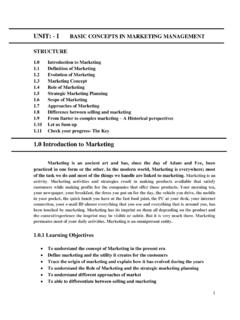Transcription of UNIT: - I BASIC CONCEPTS IN MARKETING MANAGEMENT …
1 1 UNIT: - I BASIC CONCEPTS IN MARKETING MANAGEMENT STRUCTURE Introduction to MARKETING Definition of MARKETING Evolution of MARKETING MARKETING Concept Role of MARKETING Strategic MARKETING Planning Scope of MARKETING Approaches of MARKETING Difference between selling and MARKETING From Barter to complex MARKETING A Historical perspectives Let us Sum up Check your progress- The Key Introduction to MARKETING MARKETING is an ancient art and has, since the day of Adam and Eve, been practiced in one form or the other. In the modern world, MARKETING is everywhere; most of the task we do and most of the things we handle are linked to MARKETING .
2 MARKETING is an activity. MARKETING activities and strategies result in making products available that satisfy customers while making profits for the companies that offer those products. Your morning tea, your newspaper, your breakfast, the dress you put on for the day, the vehicle you drive, the mobile in your pocket, the quick lunch you have at the fast food joint, the PC at your desk, your internet connection, your e-mail ID almost everything that you use and everything that is around you, has been touched by MARKETING . MARKETING has its imprint on them all depending on the product and the context/experience the imprint may be visible or subtle. But it is very much there.
3 MARKETING permeates most of your daily activities. MARKETING is an omnipresent entity. Learning Objectives To understand the concept of MARKETING in the present era Define MARKETING and the utility it creates for the customers Trace the origin of MARKETING and explain how it has evolved during the years To understand the Role of MARKETING and the strategic MARKETING planning To understand different approaches of market To able to differentiate between selling and MARKETING 2 Meaning of Market and MARKETING A market is any such person, group or organization which has existing or potential exchange relationship. It starts with customers and ends with customers.
4 Creation of superior customer value and delivering high levels of customer satisfaction are at the heart of present day MARKETING . Companies today, needs to understand customer needs, study completion, develop and offer superior value at reasonable price, and make the product available to customer at convenient place. Only then their products will be in demand and sell consistently. MARKETING deals with customers. It is delivery of customer satisfaction at a profit. The twofold goal of MARKETING is to attract new customers by promising superior value and to keep current customers by delivering satisfaction. Definition of MARKETING Market The concept of market has undergone significant changes over the years, commensurate with the changes in the structure and scope of markets.
5 Kotler (1) defined market as A set of all actual and potential buyers of a product. This definition implies that wherever there is a buyer of a product or service, there is a market. It succeeded in changing the view that market is a place. Further this definition also indicates that market refers to the existence of buyers of a product or service, that when these things get exchanged, the MARKETING process commences. Kohl s and Uhl (2) characterized market as an arena, wherein all buyers and sellers were highly sensitive to each other s transactions, and where what one did affected the other. 3 This concept of market focuses on a situation where all buyers and sellers would be able to communicate with one another; they would also be capable, of exchanging products with each other.
6 It could also be inferred from the definition that buyer-seller interaction is crucial to market. According to Cochrane (3) a market is some sphere or space, where certain physical and institutional arrangements could be seen, and the forces of demand and supply are at work to determine prices with a view of transferring the ownership of some quantity of good or service. This definition brings to light that the exchange takes place in a market for a consideration, , price. Apart from that, the exchange takes place with certain physical and institutional structure, there by the role of various facilities required to facilitate transfer of ownership are indicated.
7 MARKETING MARKETING refers to the various groups of activities that take place in a market. These activities are either planned or spontaneous. For example, production, assembling, distribution and storage could be planned, consumption is often spontaneous. The American MARKETING association (4) defined MARKETING as Market is an organizational function and a set of process for creating, communicating value to customers and for managing customer relationships in ways that benefit the organization and its stakeholders." According to Dahl and Hammond (5) the purpose of production, assembling, storage, and transportation was consumption.
8 All these steps from production to ultimate consumption were included in the term MARKETING . Hence, MARKETING is a set of activities without which what is produced cannot reach the ultimate consumer. Hence it might be said that the importance of these activities is the study of MARKETING . Kotler (6) says MARKETING is a societal process by which individuals and groups obtain what they need and want through creating, offering, and freely exchanging products and services of value with others. 4 To him, to define a MARKETING situation there should be two or are parties with potential interest, capable of communicating with each other and each possessing things of value to the other.
9 From this definition is could be noted that MARKETING consists of a number of facilitating activities. Often MARKETING is confused with selling. To clarify this, Kaddar s (7) distinction between the selling and MARKETING . Selling is the process by which the salesman tries to dispose of the product at the best possible price. MARKETING is much ore comprehensive and aims at maximizing the returns to the producer, at an affordable price to the consumer. MARKETING starts with production and ends with the customer finally purchasing the product. Kaddar s definition is very clear in pointing out that selling is just one activity in the MARKETING chain of activities.
10 Pyle s (8) view of MARKETING was That phase of business activity through which human wants were satisfied by the exchange of goods or services for valuable consideration usually money or its equivalent. According to Philips (9) MARKETING was all the activities necessary to place tangible goods in the hands of the customer and includes only such activities as would involve a charge in the form of the goods. This definition is narrow in the sense that it excludes creation of place and time utility and such efforts as to inform the prospective buyers to motivate them.




